ATA's Venture in Solar Power: Planning and Risk Management Report
VerifiedAdded on 2022/12/01
|10
|3291
|350
Report
AI Summary
This report details the Alternative Technology Association's (ATA) venture into providing solar power to the underprivileged citizens of East Timor, who lack access to the central power grid. The project, funded by Google, focuses on installing solar panels in individual dwellings to provide electricity, aiming to improve living conditions and promote sustainable development. The report outlines the planning and execution plan, including site identification, land acquisition (domestic-based installation), electrical engineer selection, technology provider considerations (efficient solar cells and nano crystals), tariff rate determination, permit acquisition, contract execution (demand and supply side), and funding. It also addresses operations and maintenance. Part B of the report provides a risk management plan, identifying risks such as language barriers, cultural diversity, lack of education, and government cooperation, and analyzes their potential impact. The report emphasizes the collaborative participation of stakeholders and the importance of addressing and mitigating risks for successful project implementation.
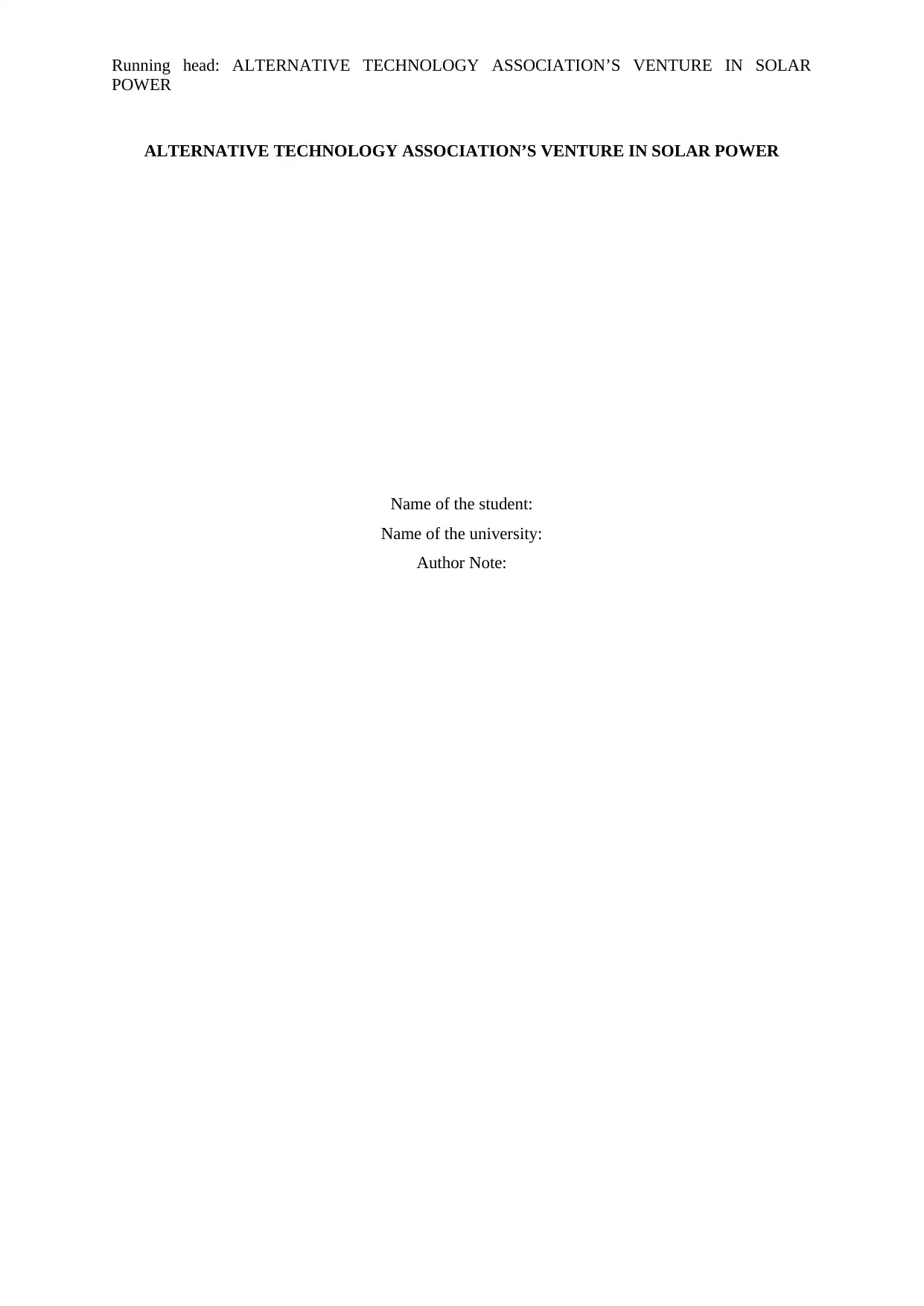
Running head: ALTERNATIVE TECHNOLOGY ASSOCIATION’S VENTURE IN SOLAR
POWER
ALTERNATIVE TECHNOLOGY ASSOCIATION’S VENTURE IN SOLAR POWER
Name of the student:
Name of the university:
Author Note:
POWER
ALTERNATIVE TECHNOLOGY ASSOCIATION’S VENTURE IN SOLAR POWER
Name of the student:
Name of the university:
Author Note:
Paraphrase This Document
Need a fresh take? Get an instant paraphrase of this document with our AI Paraphraser
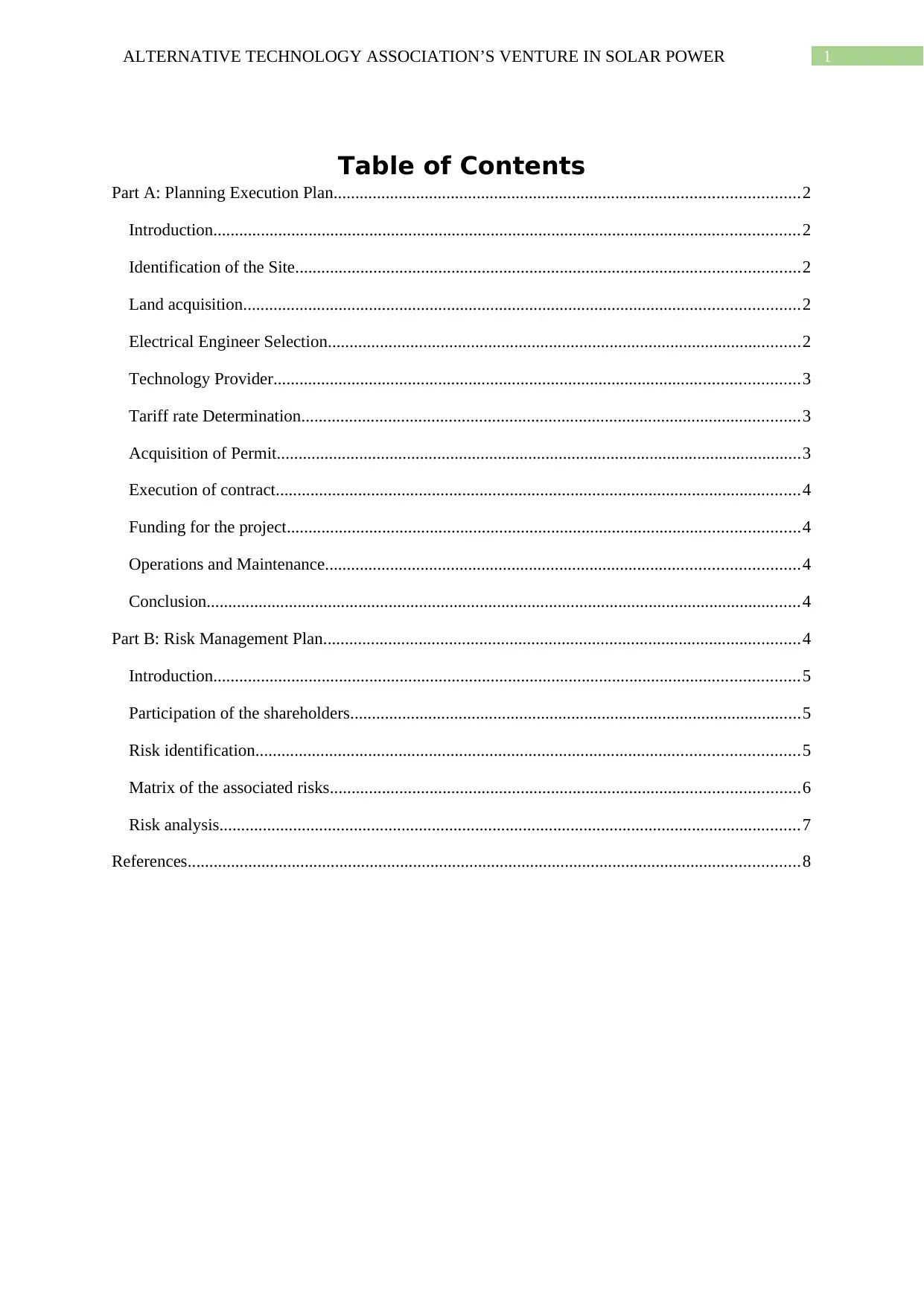
1ALTERNATIVE TECHNOLOGY ASSOCIATION’S VENTURE IN SOLAR POWER
Table of Contents
Part A: Planning Execution Plan...........................................................................................................2
Introduction.......................................................................................................................................2
Identification of the Site....................................................................................................................2
Land acquisition................................................................................................................................2
Electrical Engineer Selection.............................................................................................................2
Technology Provider.........................................................................................................................3
Tariff rate Determination...................................................................................................................3
Acquisition of Permit.........................................................................................................................3
Execution of contract.........................................................................................................................4
Funding for the project......................................................................................................................4
Operations and Maintenance.............................................................................................................4
Conclusion.........................................................................................................................................4
Part B: Risk Management Plan..............................................................................................................4
Introduction.......................................................................................................................................5
Participation of the shareholders........................................................................................................5
Risk identification.............................................................................................................................5
Matrix of the associated risks............................................................................................................6
Risk analysis......................................................................................................................................7
References.............................................................................................................................................8
Table of Contents
Part A: Planning Execution Plan...........................................................................................................2
Introduction.......................................................................................................................................2
Identification of the Site....................................................................................................................2
Land acquisition................................................................................................................................2
Electrical Engineer Selection.............................................................................................................2
Technology Provider.........................................................................................................................3
Tariff rate Determination...................................................................................................................3
Acquisition of Permit.........................................................................................................................3
Execution of contract.........................................................................................................................4
Funding for the project......................................................................................................................4
Operations and Maintenance.............................................................................................................4
Conclusion.........................................................................................................................................4
Part B: Risk Management Plan..............................................................................................................4
Introduction.......................................................................................................................................5
Participation of the shareholders........................................................................................................5
Risk identification.............................................................................................................................5
Matrix of the associated risks............................................................................................................6
Risk analysis......................................................................................................................................7
References.............................................................................................................................................8
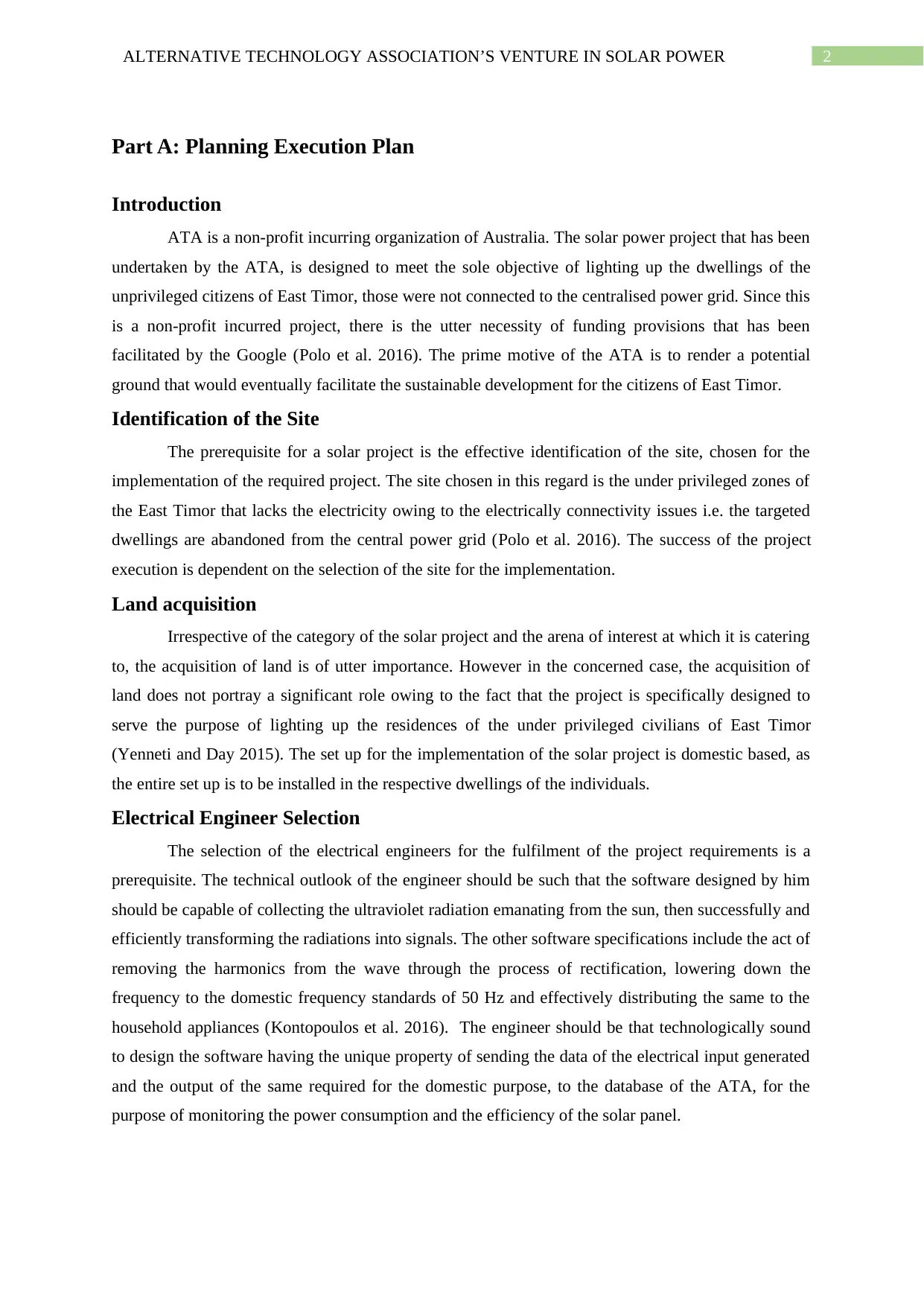
2ALTERNATIVE TECHNOLOGY ASSOCIATION’S VENTURE IN SOLAR POWER
Part A: Planning Execution Plan
Introduction
ATA is a non-profit incurring organization of Australia. The solar power project that has been
undertaken by the ATA, is designed to meet the sole objective of lighting up the dwellings of the
unprivileged citizens of East Timor, those were not connected to the centralised power grid. Since this
is a non-profit incurred project, there is the utter necessity of funding provisions that has been
facilitated by the Google (Polo et al. 2016). The prime motive of the ATA is to render a potential
ground that would eventually facilitate the sustainable development for the citizens of East Timor.
Identification of the Site
The prerequisite for a solar project is the effective identification of the site, chosen for the
implementation of the required project. The site chosen in this regard is the under privileged zones of
the East Timor that lacks the electricity owing to the electrically connectivity issues i.e. the targeted
dwellings are abandoned from the central power grid (Polo et al. 2016). The success of the project
execution is dependent on the selection of the site for the implementation.
Land acquisition
Irrespective of the category of the solar project and the arena of interest at which it is catering
to, the acquisition of land is of utter importance. However in the concerned case, the acquisition of
land does not portray a significant role owing to the fact that the project is specifically designed to
serve the purpose of lighting up the residences of the under privileged civilians of East Timor
(Yenneti and Day 2015). The set up for the implementation of the solar project is domestic based, as
the entire set up is to be installed in the respective dwellings of the individuals.
Electrical Engineer Selection
The selection of the electrical engineers for the fulfilment of the project requirements is a
prerequisite. The technical outlook of the engineer should be such that the software designed by him
should be capable of collecting the ultraviolet radiation emanating from the sun, then successfully and
efficiently transforming the radiations into signals. The other software specifications include the act of
removing the harmonics from the wave through the process of rectification, lowering down the
frequency to the domestic frequency standards of 50 Hz and effectively distributing the same to the
household appliances (Kontopoulos et al. 2016). The engineer should be that technologically sound
to design the software having the unique property of sending the data of the electrical input generated
and the output of the same required for the domestic purpose, to the database of the ATA, for the
purpose of monitoring the power consumption and the efficiency of the solar panel.
Part A: Planning Execution Plan
Introduction
ATA is a non-profit incurring organization of Australia. The solar power project that has been
undertaken by the ATA, is designed to meet the sole objective of lighting up the dwellings of the
unprivileged citizens of East Timor, those were not connected to the centralised power grid. Since this
is a non-profit incurred project, there is the utter necessity of funding provisions that has been
facilitated by the Google (Polo et al. 2016). The prime motive of the ATA is to render a potential
ground that would eventually facilitate the sustainable development for the citizens of East Timor.
Identification of the Site
The prerequisite for a solar project is the effective identification of the site, chosen for the
implementation of the required project. The site chosen in this regard is the under privileged zones of
the East Timor that lacks the electricity owing to the electrically connectivity issues i.e. the targeted
dwellings are abandoned from the central power grid (Polo et al. 2016). The success of the project
execution is dependent on the selection of the site for the implementation.
Land acquisition
Irrespective of the category of the solar project and the arena of interest at which it is catering
to, the acquisition of land is of utter importance. However in the concerned case, the acquisition of
land does not portray a significant role owing to the fact that the project is specifically designed to
serve the purpose of lighting up the residences of the under privileged civilians of East Timor
(Yenneti and Day 2015). The set up for the implementation of the solar project is domestic based, as
the entire set up is to be installed in the respective dwellings of the individuals.
Electrical Engineer Selection
The selection of the electrical engineers for the fulfilment of the project requirements is a
prerequisite. The technical outlook of the engineer should be such that the software designed by him
should be capable of collecting the ultraviolet radiation emanating from the sun, then successfully and
efficiently transforming the radiations into signals. The other software specifications include the act of
removing the harmonics from the wave through the process of rectification, lowering down the
frequency to the domestic frequency standards of 50 Hz and effectively distributing the same to the
household appliances (Kontopoulos et al. 2016). The engineer should be that technologically sound
to design the software having the unique property of sending the data of the electrical input generated
and the output of the same required for the domestic purpose, to the database of the ATA, for the
purpose of monitoring the power consumption and the efficiency of the solar panel.
⊘ This is a preview!⊘
Do you want full access?
Subscribe today to unlock all pages.

Trusted by 1+ million students worldwide
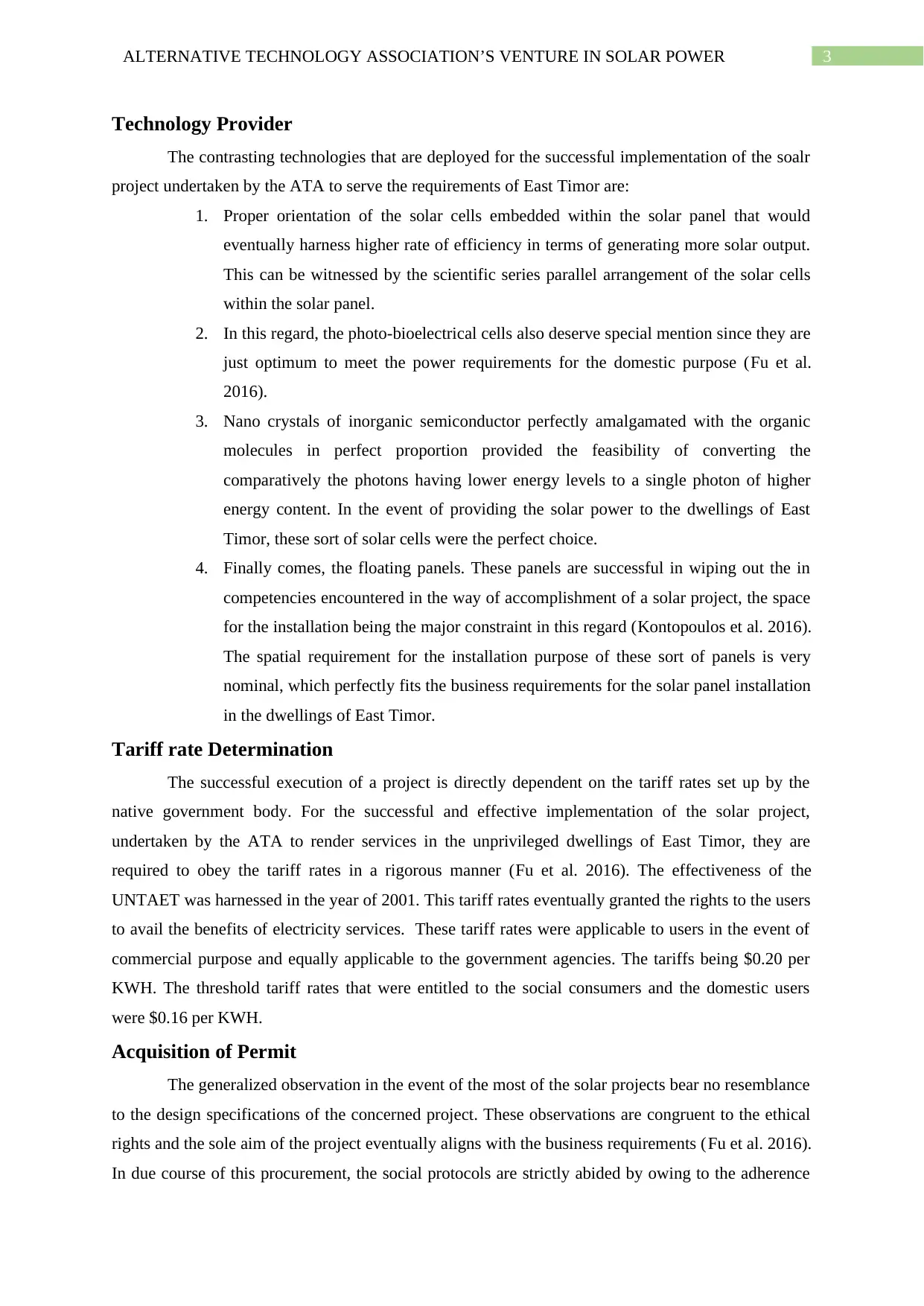
3ALTERNATIVE TECHNOLOGY ASSOCIATION’S VENTURE IN SOLAR POWER
Technology Provider
The contrasting technologies that are deployed for the successful implementation of the soalr
project undertaken by the ATA to serve the requirements of East Timor are:
1. Proper orientation of the solar cells embedded within the solar panel that would
eventually harness higher rate of efficiency in terms of generating more solar output.
This can be witnessed by the scientific series parallel arrangement of the solar cells
within the solar panel.
2. In this regard, the photo-bioelectrical cells also deserve special mention since they are
just optimum to meet the power requirements for the domestic purpose (Fu et al.
2016).
3. Nano crystals of inorganic semiconductor perfectly amalgamated with the organic
molecules in perfect proportion provided the feasibility of converting the
comparatively the photons having lower energy levels to a single photon of higher
energy content. In the event of providing the solar power to the dwellings of East
Timor, these sort of solar cells were the perfect choice.
4. Finally comes, the floating panels. These panels are successful in wiping out the in
competencies encountered in the way of accomplishment of a solar project, the space
for the installation being the major constraint in this regard (Kontopoulos et al. 2016).
The spatial requirement for the installation purpose of these sort of panels is very
nominal, which perfectly fits the business requirements for the solar panel installation
in the dwellings of East Timor.
Tariff rate Determination
The successful execution of a project is directly dependent on the tariff rates set up by the
native government body. For the successful and effective implementation of the solar project,
undertaken by the ATA to render services in the unprivileged dwellings of East Timor, they are
required to obey the tariff rates in a rigorous manner (Fu et al. 2016). The effectiveness of the
UNTAET was harnessed in the year of 2001. This tariff rates eventually granted the rights to the users
to avail the benefits of electricity services. These tariff rates were applicable to users in the event of
commercial purpose and equally applicable to the government agencies. The tariffs being $0.20 per
KWH. The threshold tariff rates that were entitled to the social consumers and the domestic users
were $0.16 per KWH.
Acquisition of Permit
The generalized observation in the event of the most of the solar projects bear no resemblance
to the design specifications of the concerned project. These observations are congruent to the ethical
rights and the sole aim of the project eventually aligns with the business requirements (Fu et al. 2016).
In due course of this procurement, the social protocols are strictly abided by owing to the adherence
Technology Provider
The contrasting technologies that are deployed for the successful implementation of the soalr
project undertaken by the ATA to serve the requirements of East Timor are:
1. Proper orientation of the solar cells embedded within the solar panel that would
eventually harness higher rate of efficiency in terms of generating more solar output.
This can be witnessed by the scientific series parallel arrangement of the solar cells
within the solar panel.
2. In this regard, the photo-bioelectrical cells also deserve special mention since they are
just optimum to meet the power requirements for the domestic purpose (Fu et al.
2016).
3. Nano crystals of inorganic semiconductor perfectly amalgamated with the organic
molecules in perfect proportion provided the feasibility of converting the
comparatively the photons having lower energy levels to a single photon of higher
energy content. In the event of providing the solar power to the dwellings of East
Timor, these sort of solar cells were the perfect choice.
4. Finally comes, the floating panels. These panels are successful in wiping out the in
competencies encountered in the way of accomplishment of a solar project, the space
for the installation being the major constraint in this regard (Kontopoulos et al. 2016).
The spatial requirement for the installation purpose of these sort of panels is very
nominal, which perfectly fits the business requirements for the solar panel installation
in the dwellings of East Timor.
Tariff rate Determination
The successful execution of a project is directly dependent on the tariff rates set up by the
native government body. For the successful and effective implementation of the solar project,
undertaken by the ATA to render services in the unprivileged dwellings of East Timor, they are
required to obey the tariff rates in a rigorous manner (Fu et al. 2016). The effectiveness of the
UNTAET was harnessed in the year of 2001. This tariff rates eventually granted the rights to the users
to avail the benefits of electricity services. These tariff rates were applicable to users in the event of
commercial purpose and equally applicable to the government agencies. The tariffs being $0.20 per
KWH. The threshold tariff rates that were entitled to the social consumers and the domestic users
were $0.16 per KWH.
Acquisition of Permit
The generalized observation in the event of the most of the solar projects bear no resemblance
to the design specifications of the concerned project. These observations are congruent to the ethical
rights and the sole aim of the project eventually aligns with the business requirements (Fu et al. 2016).
In due course of this procurement, the social protocols are strictly abided by owing to the adherence
Paraphrase This Document
Need a fresh take? Get an instant paraphrase of this document with our AI Paraphraser
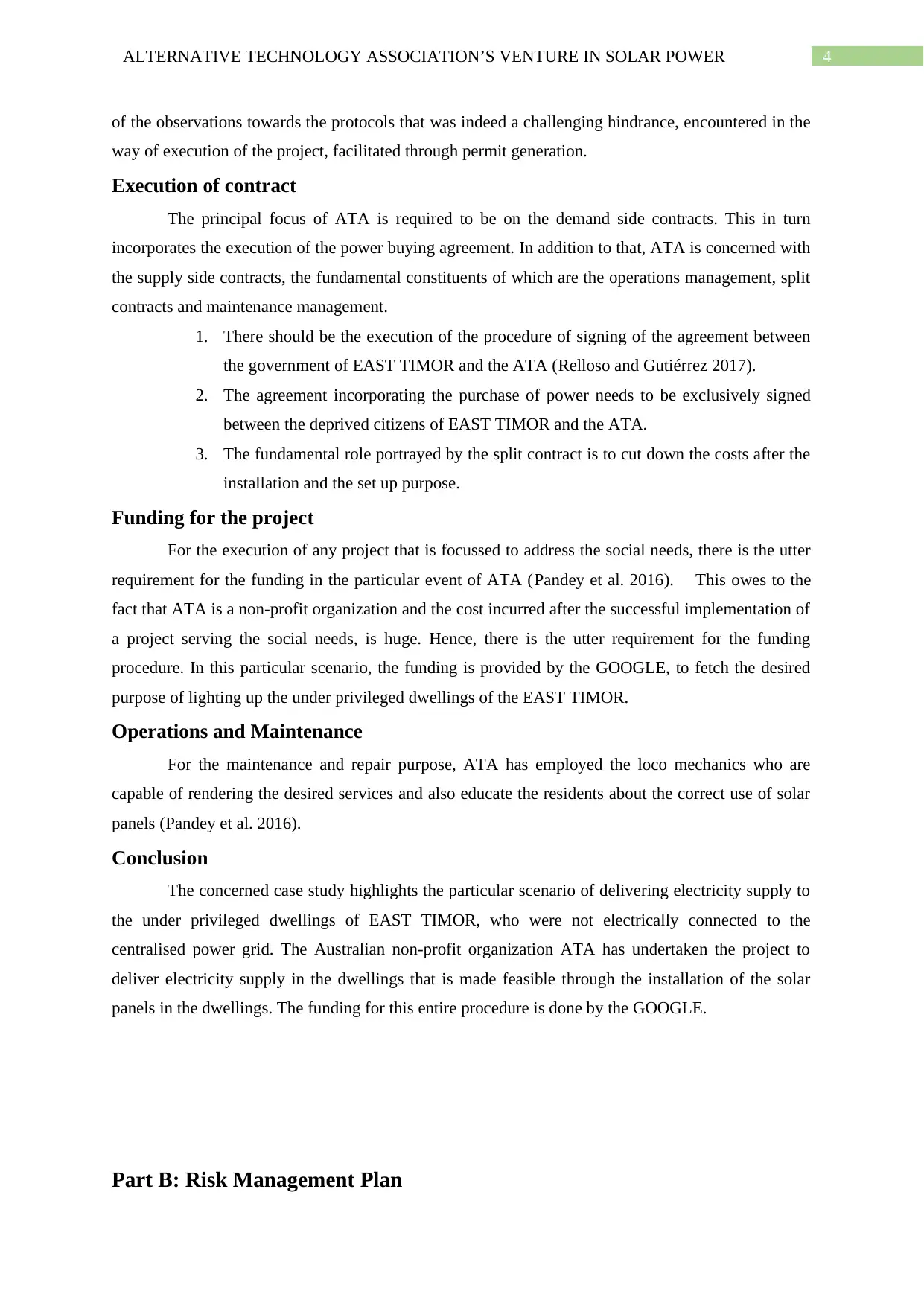
4ALTERNATIVE TECHNOLOGY ASSOCIATION’S VENTURE IN SOLAR POWER
of the observations towards the protocols that was indeed a challenging hindrance, encountered in the
way of execution of the project, facilitated through permit generation.
Execution of contract
The principal focus of ATA is required to be on the demand side contracts. This in turn
incorporates the execution of the power buying agreement. In addition to that, ATA is concerned with
the supply side contracts, the fundamental constituents of which are the operations management, split
contracts and maintenance management.
1. There should be the execution of the procedure of signing of the agreement between
the government of EAST TIMOR and the ATA (Relloso and Gutiérrez 2017).
2. The agreement incorporating the purchase of power needs to be exclusively signed
between the deprived citizens of EAST TIMOR and the ATA.
3. The fundamental role portrayed by the split contract is to cut down the costs after the
installation and the set up purpose.
Funding for the project
For the execution of any project that is focussed to address the social needs, there is the utter
requirement for the funding in the particular event of ATA (Pandey et al. 2016). This owes to the
fact that ATA is a non-profit organization and the cost incurred after the successful implementation of
a project serving the social needs, is huge. Hence, there is the utter requirement for the funding
procedure. In this particular scenario, the funding is provided by the GOOGLE, to fetch the desired
purpose of lighting up the under privileged dwellings of the EAST TIMOR.
Operations and Maintenance
For the maintenance and repair purpose, ATA has employed the loco mechanics who are
capable of rendering the desired services and also educate the residents about the correct use of solar
panels (Pandey et al. 2016).
Conclusion
The concerned case study highlights the particular scenario of delivering electricity supply to
the under privileged dwellings of EAST TIMOR, who were not electrically connected to the
centralised power grid. The Australian non-profit organization ATA has undertaken the project to
deliver electricity supply in the dwellings that is made feasible through the installation of the solar
panels in the dwellings. The funding for this entire procedure is done by the GOOGLE.
Part B: Risk Management Plan
of the observations towards the protocols that was indeed a challenging hindrance, encountered in the
way of execution of the project, facilitated through permit generation.
Execution of contract
The principal focus of ATA is required to be on the demand side contracts. This in turn
incorporates the execution of the power buying agreement. In addition to that, ATA is concerned with
the supply side contracts, the fundamental constituents of which are the operations management, split
contracts and maintenance management.
1. There should be the execution of the procedure of signing of the agreement between
the government of EAST TIMOR and the ATA (Relloso and Gutiérrez 2017).
2. The agreement incorporating the purchase of power needs to be exclusively signed
between the deprived citizens of EAST TIMOR and the ATA.
3. The fundamental role portrayed by the split contract is to cut down the costs after the
installation and the set up purpose.
Funding for the project
For the execution of any project that is focussed to address the social needs, there is the utter
requirement for the funding in the particular event of ATA (Pandey et al. 2016). This owes to the
fact that ATA is a non-profit organization and the cost incurred after the successful implementation of
a project serving the social needs, is huge. Hence, there is the utter requirement for the funding
procedure. In this particular scenario, the funding is provided by the GOOGLE, to fetch the desired
purpose of lighting up the under privileged dwellings of the EAST TIMOR.
Operations and Maintenance
For the maintenance and repair purpose, ATA has employed the loco mechanics who are
capable of rendering the desired services and also educate the residents about the correct use of solar
panels (Pandey et al. 2016).
Conclusion
The concerned case study highlights the particular scenario of delivering electricity supply to
the under privileged dwellings of EAST TIMOR, who were not electrically connected to the
centralised power grid. The Australian non-profit organization ATA has undertaken the project to
deliver electricity supply in the dwellings that is made feasible through the installation of the solar
panels in the dwellings. The funding for this entire procedure is done by the GOOGLE.
Part B: Risk Management Plan
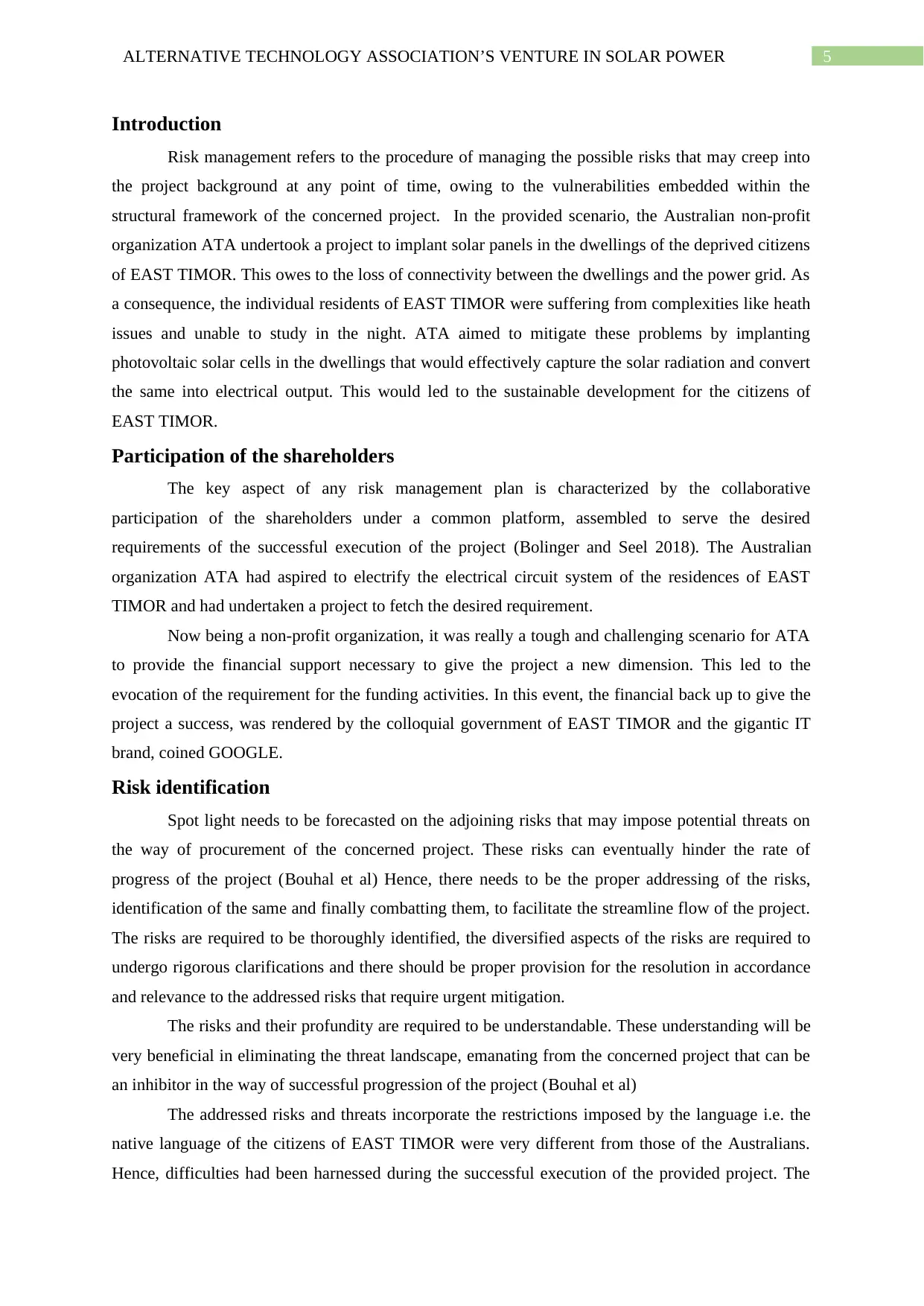
5ALTERNATIVE TECHNOLOGY ASSOCIATION’S VENTURE IN SOLAR POWER
Introduction
Risk management refers to the procedure of managing the possible risks that may creep into
the project background at any point of time, owing to the vulnerabilities embedded within the
structural framework of the concerned project. In the provided scenario, the Australian non-profit
organization ATA undertook a project to implant solar panels in the dwellings of the deprived citizens
of EAST TIMOR. This owes to the loss of connectivity between the dwellings and the power grid. As
a consequence, the individual residents of EAST TIMOR were suffering from complexities like heath
issues and unable to study in the night. ATA aimed to mitigate these problems by implanting
photovoltaic solar cells in the dwellings that would effectively capture the solar radiation and convert
the same into electrical output. This would led to the sustainable development for the citizens of
EAST TIMOR.
Participation of the shareholders
The key aspect of any risk management plan is characterized by the collaborative
participation of the shareholders under a common platform, assembled to serve the desired
requirements of the successful execution of the project (Bolinger and Seel 2018). The Australian
organization ATA had aspired to electrify the electrical circuit system of the residences of EAST
TIMOR and had undertaken a project to fetch the desired requirement.
Now being a non-profit organization, it was really a tough and challenging scenario for ATA
to provide the financial support necessary to give the project a new dimension. This led to the
evocation of the requirement for the funding activities. In this event, the financial back up to give the
project a success, was rendered by the colloquial government of EAST TIMOR and the gigantic IT
brand, coined GOOGLE.
Risk identification
Spot light needs to be forecasted on the adjoining risks that may impose potential threats on
the way of procurement of the concerned project. These risks can eventually hinder the rate of
progress of the project (Bouhal et al) Hence, there needs to be the proper addressing of the risks,
identification of the same and finally combatting them, to facilitate the streamline flow of the project.
The risks are required to be thoroughly identified, the diversified aspects of the risks are required to
undergo rigorous clarifications and there should be proper provision for the resolution in accordance
and relevance to the addressed risks that require urgent mitigation.
The risks and their profundity are required to be understandable. These understanding will be
very beneficial in eliminating the threat landscape, emanating from the concerned project that can be
an inhibitor in the way of successful progression of the project (Bouhal et al)
The addressed risks and threats incorporate the restrictions imposed by the language i.e. the
native language of the citizens of EAST TIMOR were very different from those of the Australians.
Hence, difficulties had been harnessed during the successful execution of the provided project. The
Introduction
Risk management refers to the procedure of managing the possible risks that may creep into
the project background at any point of time, owing to the vulnerabilities embedded within the
structural framework of the concerned project. In the provided scenario, the Australian non-profit
organization ATA undertook a project to implant solar panels in the dwellings of the deprived citizens
of EAST TIMOR. This owes to the loss of connectivity between the dwellings and the power grid. As
a consequence, the individual residents of EAST TIMOR were suffering from complexities like heath
issues and unable to study in the night. ATA aimed to mitigate these problems by implanting
photovoltaic solar cells in the dwellings that would effectively capture the solar radiation and convert
the same into electrical output. This would led to the sustainable development for the citizens of
EAST TIMOR.
Participation of the shareholders
The key aspect of any risk management plan is characterized by the collaborative
participation of the shareholders under a common platform, assembled to serve the desired
requirements of the successful execution of the project (Bolinger and Seel 2018). The Australian
organization ATA had aspired to electrify the electrical circuit system of the residences of EAST
TIMOR and had undertaken a project to fetch the desired requirement.
Now being a non-profit organization, it was really a tough and challenging scenario for ATA
to provide the financial support necessary to give the project a new dimension. This led to the
evocation of the requirement for the funding activities. In this event, the financial back up to give the
project a success, was rendered by the colloquial government of EAST TIMOR and the gigantic IT
brand, coined GOOGLE.
Risk identification
Spot light needs to be forecasted on the adjoining risks that may impose potential threats on
the way of procurement of the concerned project. These risks can eventually hinder the rate of
progress of the project (Bouhal et al) Hence, there needs to be the proper addressing of the risks,
identification of the same and finally combatting them, to facilitate the streamline flow of the project.
The risks are required to be thoroughly identified, the diversified aspects of the risks are required to
undergo rigorous clarifications and there should be proper provision for the resolution in accordance
and relevance to the addressed risks that require urgent mitigation.
The risks and their profundity are required to be understandable. These understanding will be
very beneficial in eliminating the threat landscape, emanating from the concerned project that can be
an inhibitor in the way of successful progression of the project (Bouhal et al)
The addressed risks and threats incorporate the restrictions imposed by the language i.e. the
native language of the citizens of EAST TIMOR were very different from those of the Australians.
Hence, difficulties had been harnessed during the successful execution of the provided project. The
⊘ This is a preview!⊘
Do you want full access?
Subscribe today to unlock all pages.

Trusted by 1+ million students worldwide
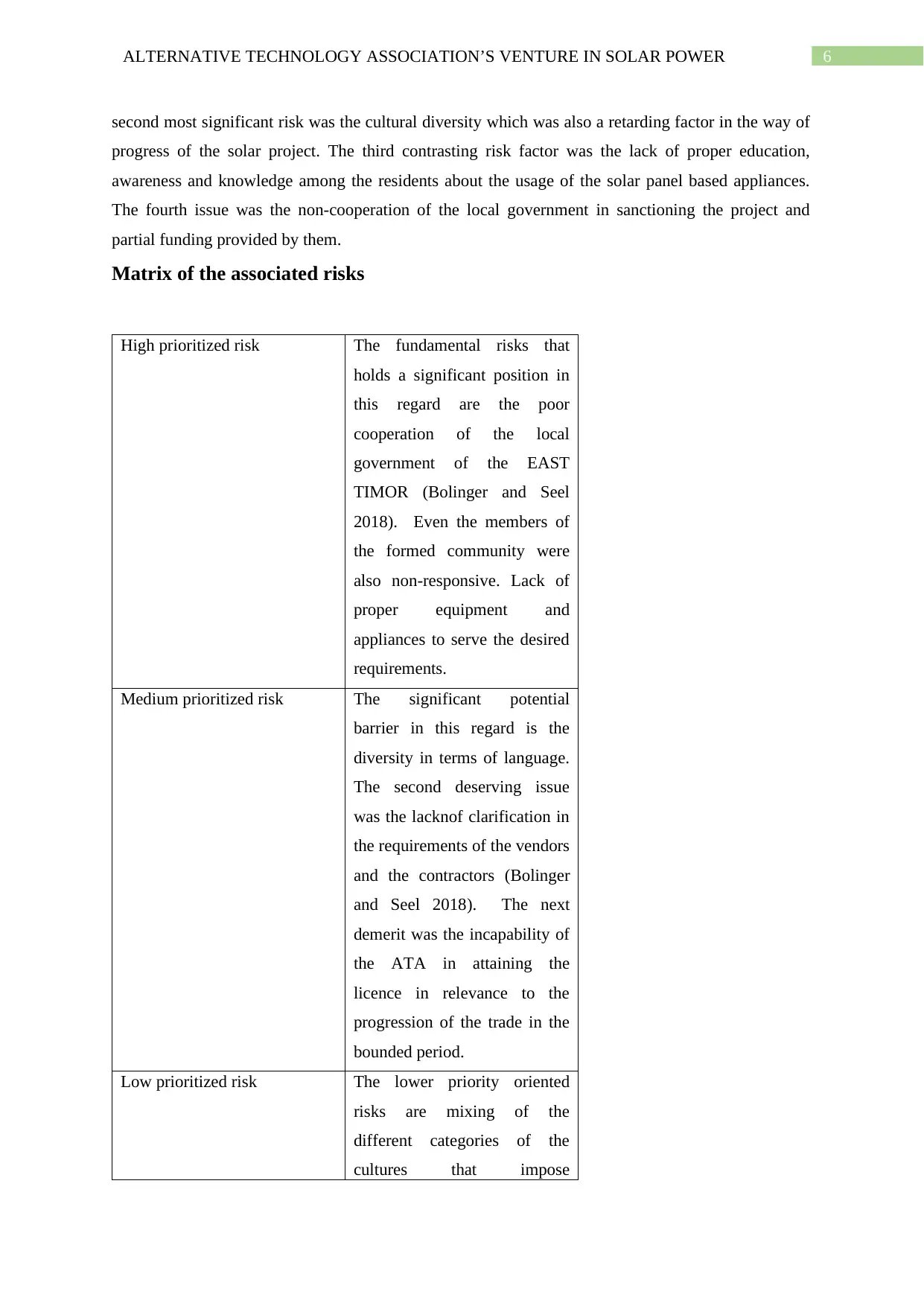
6ALTERNATIVE TECHNOLOGY ASSOCIATION’S VENTURE IN SOLAR POWER
second most significant risk was the cultural diversity which was also a retarding factor in the way of
progress of the solar project. The third contrasting risk factor was the lack of proper education,
awareness and knowledge among the residents about the usage of the solar panel based appliances.
The fourth issue was the non-cooperation of the local government in sanctioning the project and
partial funding provided by them.
Matrix of the associated risks
High prioritized risk The fundamental risks that
holds a significant position in
this regard are the poor
cooperation of the local
government of the EAST
TIMOR (Bolinger and Seel
2018). Even the members of
the formed community were
also non-responsive. Lack of
proper equipment and
appliances to serve the desired
requirements.
Medium prioritized risk The significant potential
barrier in this regard is the
diversity in terms of language.
The second deserving issue
was the lacknof clarification in
the requirements of the vendors
and the contractors (Bolinger
and Seel 2018). The next
demerit was the incapability of
the ATA in attaining the
licence in relevance to the
progression of the trade in the
bounded period.
Low prioritized risk The lower priority oriented
risks are mixing of the
different categories of the
cultures that impose
second most significant risk was the cultural diversity which was also a retarding factor in the way of
progress of the solar project. The third contrasting risk factor was the lack of proper education,
awareness and knowledge among the residents about the usage of the solar panel based appliances.
The fourth issue was the non-cooperation of the local government in sanctioning the project and
partial funding provided by them.
Matrix of the associated risks
High prioritized risk The fundamental risks that
holds a significant position in
this regard are the poor
cooperation of the local
government of the EAST
TIMOR (Bolinger and Seel
2018). Even the members of
the formed community were
also non-responsive. Lack of
proper equipment and
appliances to serve the desired
requirements.
Medium prioritized risk The significant potential
barrier in this regard is the
diversity in terms of language.
The second deserving issue
was the lacknof clarification in
the requirements of the vendors
and the contractors (Bolinger
and Seel 2018). The next
demerit was the incapability of
the ATA in attaining the
licence in relevance to the
progression of the trade in the
bounded period.
Low prioritized risk The lower priority oriented
risks are mixing of the
different categories of the
cultures that impose
Paraphrase This Document
Need a fresh take? Get an instant paraphrase of this document with our AI Paraphraser
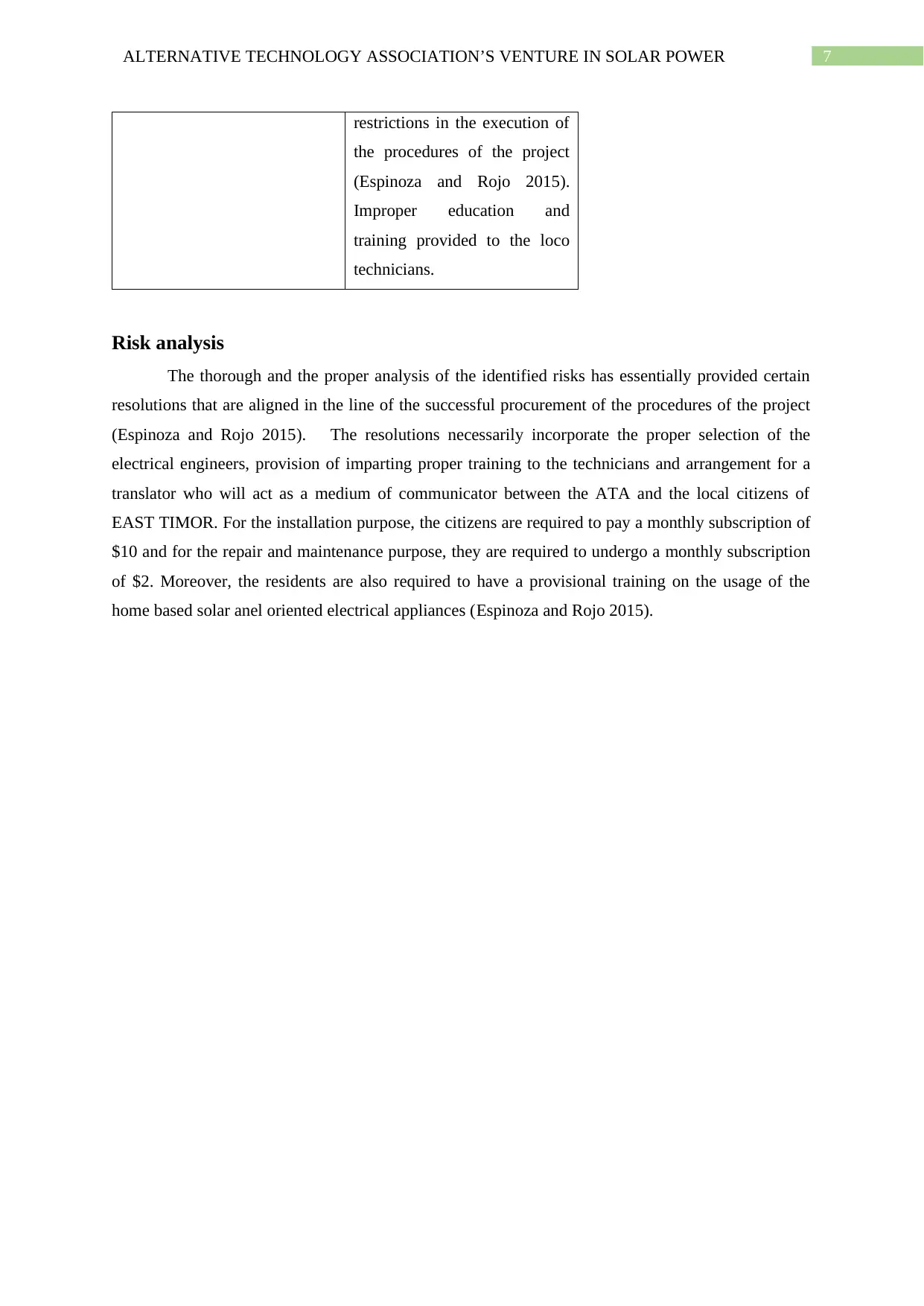
7ALTERNATIVE TECHNOLOGY ASSOCIATION’S VENTURE IN SOLAR POWER
restrictions in the execution of
the procedures of the project
(Espinoza and Rojo 2015).
Improper education and
training provided to the loco
technicians.
Risk analysis
The thorough and the proper analysis of the identified risks has essentially provided certain
resolutions that are aligned in the line of the successful procurement of the procedures of the project
(Espinoza and Rojo 2015). The resolutions necessarily incorporate the proper selection of the
electrical engineers, provision of imparting proper training to the technicians and arrangement for a
translator who will act as a medium of communicator between the ATA and the local citizens of
EAST TIMOR. For the installation purpose, the citizens are required to pay a monthly subscription of
$10 and for the repair and maintenance purpose, they are required to undergo a monthly subscription
of $2. Moreover, the residents are also required to have a provisional training on the usage of the
home based solar anel oriented electrical appliances (Espinoza and Rojo 2015).
restrictions in the execution of
the procedures of the project
(Espinoza and Rojo 2015).
Improper education and
training provided to the loco
technicians.
Risk analysis
The thorough and the proper analysis of the identified risks has essentially provided certain
resolutions that are aligned in the line of the successful procurement of the procedures of the project
(Espinoza and Rojo 2015). The resolutions necessarily incorporate the proper selection of the
electrical engineers, provision of imparting proper training to the technicians and arrangement for a
translator who will act as a medium of communicator between the ATA and the local citizens of
EAST TIMOR. For the installation purpose, the citizens are required to pay a monthly subscription of
$10 and for the repair and maintenance purpose, they are required to undergo a monthly subscription
of $2. Moreover, the residents are also required to have a provisional training on the usage of the
home based solar anel oriented electrical appliances (Espinoza and Rojo 2015).
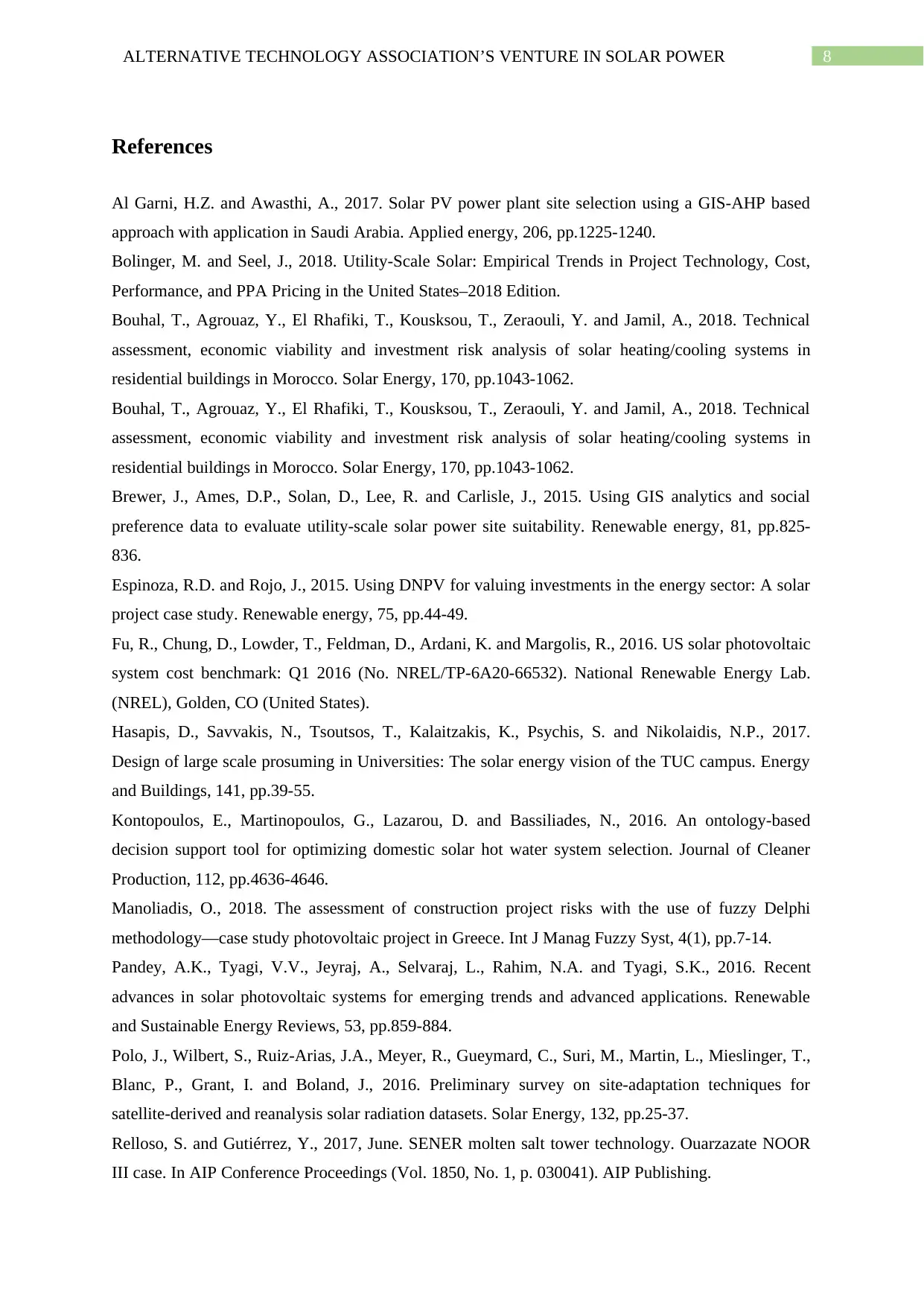
8ALTERNATIVE TECHNOLOGY ASSOCIATION’S VENTURE IN SOLAR POWER
References
Al Garni, H.Z. and Awasthi, A., 2017. Solar PV power plant site selection using a GIS-AHP based
approach with application in Saudi Arabia. Applied energy, 206, pp.1225-1240.
Bolinger, M. and Seel, J., 2018. Utility-Scale Solar: Empirical Trends in Project Technology, Cost,
Performance, and PPA Pricing in the United States–2018 Edition.
Bouhal, T., Agrouaz, Y., El Rhafiki, T., Kousksou, T., Zeraouli, Y. and Jamil, A., 2018. Technical
assessment, economic viability and investment risk analysis of solar heating/cooling systems in
residential buildings in Morocco. Solar Energy, 170, pp.1043-1062.
Bouhal, T., Agrouaz, Y., El Rhafiki, T., Kousksou, T., Zeraouli, Y. and Jamil, A., 2018. Technical
assessment, economic viability and investment risk analysis of solar heating/cooling systems in
residential buildings in Morocco. Solar Energy, 170, pp.1043-1062.
Brewer, J., Ames, D.P., Solan, D., Lee, R. and Carlisle, J., 2015. Using GIS analytics and social
preference data to evaluate utility-scale solar power site suitability. Renewable energy, 81, pp.825-
836.
Espinoza, R.D. and Rojo, J., 2015. Using DNPV for valuing investments in the energy sector: A solar
project case study. Renewable energy, 75, pp.44-49.
Fu, R., Chung, D., Lowder, T., Feldman, D., Ardani, K. and Margolis, R., 2016. US solar photovoltaic
system cost benchmark: Q1 2016 (No. NREL/TP-6A20-66532). National Renewable Energy Lab.
(NREL), Golden, CO (United States).
Hasapis, D., Savvakis, N., Tsoutsos, T., Kalaitzakis, K., Psychis, S. and Nikolaidis, N.P., 2017.
Design of large scale prosuming in Universities: The solar energy vision of the TUC campus. Energy
and Buildings, 141, pp.39-55.
Kontopoulos, E., Martinopoulos, G., Lazarou, D. and Bassiliades, N., 2016. An ontology-based
decision support tool for optimizing domestic solar hot water system selection. Journal of Cleaner
Production, 112, pp.4636-4646.
Manoliadis, O., 2018. The assessment of construction project risks with the use of fuzzy Delphi
methodology—case study photovoltaic project in Greece. Int J Manag Fuzzy Syst, 4(1), pp.7-14.
Pandey, A.K., Tyagi, V.V., Jeyraj, A., Selvaraj, L., Rahim, N.A. and Tyagi, S.K., 2016. Recent
advances in solar photovoltaic systems for emerging trends and advanced applications. Renewable
and Sustainable Energy Reviews, 53, pp.859-884.
Polo, J., Wilbert, S., Ruiz-Arias, J.A., Meyer, R., Gueymard, C., Suri, M., Martin, L., Mieslinger, T.,
Blanc, P., Grant, I. and Boland, J., 2016. Preliminary survey on site-adaptation techniques for
satellite-derived and reanalysis solar radiation datasets. Solar Energy, 132, pp.25-37.
Relloso, S. and Gutiérrez, Y., 2017, June. SENER molten salt tower technology. Ouarzazate NOOR
III case. In AIP Conference Proceedings (Vol. 1850, No. 1, p. 030041). AIP Publishing.
References
Al Garni, H.Z. and Awasthi, A., 2017. Solar PV power plant site selection using a GIS-AHP based
approach with application in Saudi Arabia. Applied energy, 206, pp.1225-1240.
Bolinger, M. and Seel, J., 2018. Utility-Scale Solar: Empirical Trends in Project Technology, Cost,
Performance, and PPA Pricing in the United States–2018 Edition.
Bouhal, T., Agrouaz, Y., El Rhafiki, T., Kousksou, T., Zeraouli, Y. and Jamil, A., 2018. Technical
assessment, economic viability and investment risk analysis of solar heating/cooling systems in
residential buildings in Morocco. Solar Energy, 170, pp.1043-1062.
Bouhal, T., Agrouaz, Y., El Rhafiki, T., Kousksou, T., Zeraouli, Y. and Jamil, A., 2018. Technical
assessment, economic viability and investment risk analysis of solar heating/cooling systems in
residential buildings in Morocco. Solar Energy, 170, pp.1043-1062.
Brewer, J., Ames, D.P., Solan, D., Lee, R. and Carlisle, J., 2015. Using GIS analytics and social
preference data to evaluate utility-scale solar power site suitability. Renewable energy, 81, pp.825-
836.
Espinoza, R.D. and Rojo, J., 2015. Using DNPV for valuing investments in the energy sector: A solar
project case study. Renewable energy, 75, pp.44-49.
Fu, R., Chung, D., Lowder, T., Feldman, D., Ardani, K. and Margolis, R., 2016. US solar photovoltaic
system cost benchmark: Q1 2016 (No. NREL/TP-6A20-66532). National Renewable Energy Lab.
(NREL), Golden, CO (United States).
Hasapis, D., Savvakis, N., Tsoutsos, T., Kalaitzakis, K., Psychis, S. and Nikolaidis, N.P., 2017.
Design of large scale prosuming in Universities: The solar energy vision of the TUC campus. Energy
and Buildings, 141, pp.39-55.
Kontopoulos, E., Martinopoulos, G., Lazarou, D. and Bassiliades, N., 2016. An ontology-based
decision support tool for optimizing domestic solar hot water system selection. Journal of Cleaner
Production, 112, pp.4636-4646.
Manoliadis, O., 2018. The assessment of construction project risks with the use of fuzzy Delphi
methodology—case study photovoltaic project in Greece. Int J Manag Fuzzy Syst, 4(1), pp.7-14.
Pandey, A.K., Tyagi, V.V., Jeyraj, A., Selvaraj, L., Rahim, N.A. and Tyagi, S.K., 2016. Recent
advances in solar photovoltaic systems for emerging trends and advanced applications. Renewable
and Sustainable Energy Reviews, 53, pp.859-884.
Polo, J., Wilbert, S., Ruiz-Arias, J.A., Meyer, R., Gueymard, C., Suri, M., Martin, L., Mieslinger, T.,
Blanc, P., Grant, I. and Boland, J., 2016. Preliminary survey on site-adaptation techniques for
satellite-derived and reanalysis solar radiation datasets. Solar Energy, 132, pp.25-37.
Relloso, S. and Gutiérrez, Y., 2017, June. SENER molten salt tower technology. Ouarzazate NOOR
III case. In AIP Conference Proceedings (Vol. 1850, No. 1, p. 030041). AIP Publishing.
⊘ This is a preview!⊘
Do you want full access?
Subscribe today to unlock all pages.

Trusted by 1+ million students worldwide
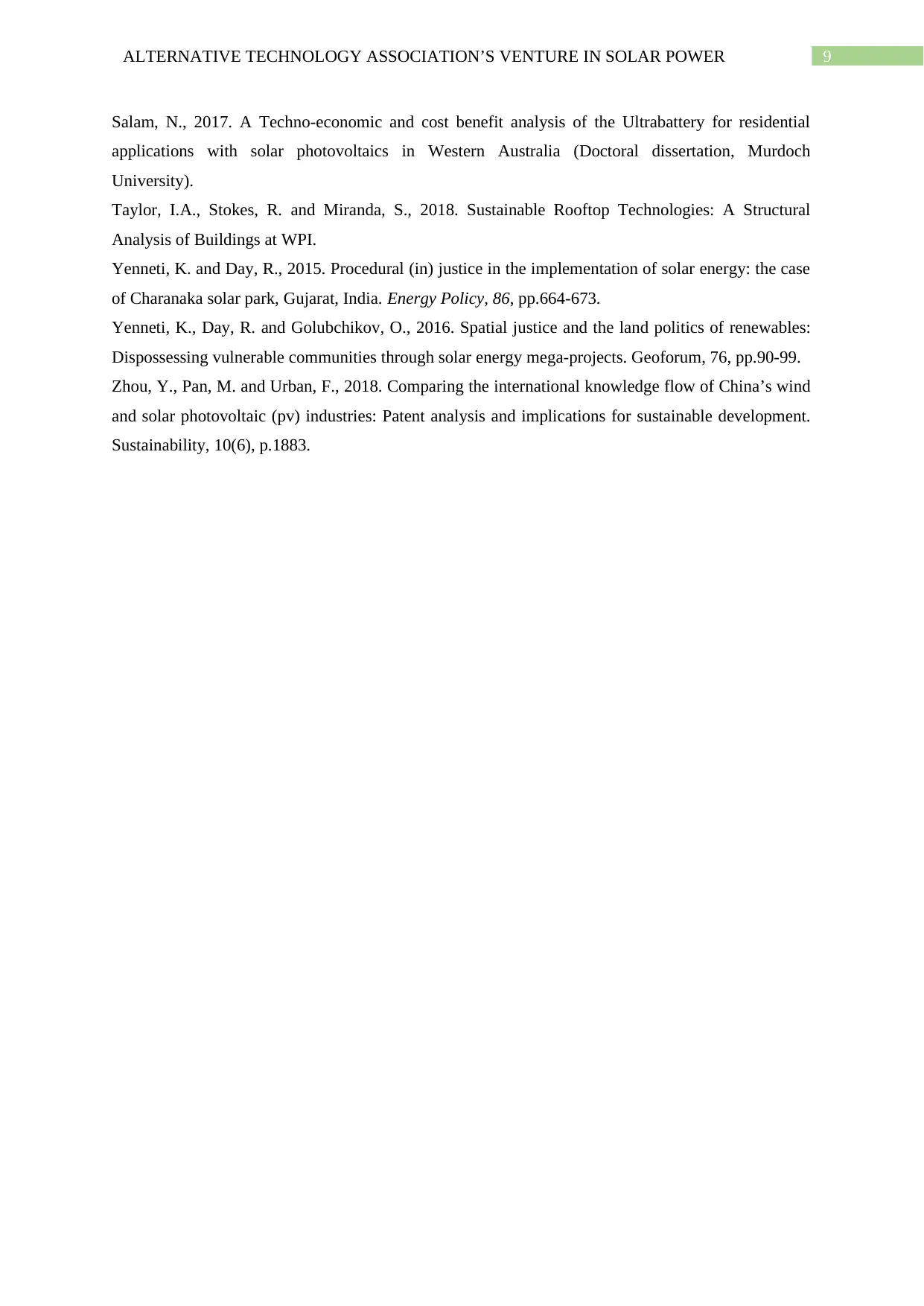
9ALTERNATIVE TECHNOLOGY ASSOCIATION’S VENTURE IN SOLAR POWER
Salam, N., 2017. A Techno-economic and cost benefit analysis of the Ultrabattery for residential
applications with solar photovoltaics in Western Australia (Doctoral dissertation, Murdoch
University).
Taylor, I.A., Stokes, R. and Miranda, S., 2018. Sustainable Rooftop Technologies: A Structural
Analysis of Buildings at WPI.
Yenneti, K. and Day, R., 2015. Procedural (in) justice in the implementation of solar energy: the case
of Charanaka solar park, Gujarat, India. Energy Policy, 86, pp.664-673.
Yenneti, K., Day, R. and Golubchikov, O., 2016. Spatial justice and the land politics of renewables:
Dispossessing vulnerable communities through solar energy mega-projects. Geoforum, 76, pp.90-99.
Zhou, Y., Pan, M. and Urban, F., 2018. Comparing the international knowledge flow of China’s wind
and solar photovoltaic (pv) industries: Patent analysis and implications for sustainable development.
Sustainability, 10(6), p.1883.
Salam, N., 2017. A Techno-economic and cost benefit analysis of the Ultrabattery for residential
applications with solar photovoltaics in Western Australia (Doctoral dissertation, Murdoch
University).
Taylor, I.A., Stokes, R. and Miranda, S., 2018. Sustainable Rooftop Technologies: A Structural
Analysis of Buildings at WPI.
Yenneti, K. and Day, R., 2015. Procedural (in) justice in the implementation of solar energy: the case
of Charanaka solar park, Gujarat, India. Energy Policy, 86, pp.664-673.
Yenneti, K., Day, R. and Golubchikov, O., 2016. Spatial justice and the land politics of renewables:
Dispossessing vulnerable communities through solar energy mega-projects. Geoforum, 76, pp.90-99.
Zhou, Y., Pan, M. and Urban, F., 2018. Comparing the international knowledge flow of China’s wind
and solar photovoltaic (pv) industries: Patent analysis and implications for sustainable development.
Sustainability, 10(6), p.1883.
1 out of 10
Related Documents
Your All-in-One AI-Powered Toolkit for Academic Success.
+13062052269
info@desklib.com
Available 24*7 on WhatsApp / Email
![[object Object]](/_next/static/media/star-bottom.7253800d.svg)
Unlock your academic potential
Copyright © 2020–2025 A2Z Services. All Rights Reserved. Developed and managed by ZUCOL.





